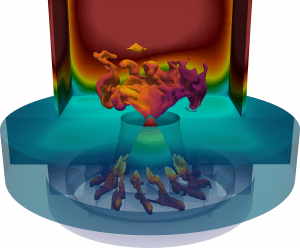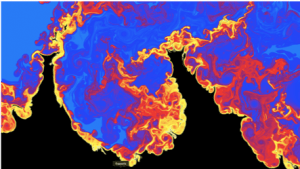EU energy 2050 roadmap asking for “zero-net” CO2 emissions by 2050 calls for the decarbonation of energy in all energy production systems, with application in aeronautical propulsion, ground-based gas turbines for power generation, industrial furnaces and many other systems. A direct way to achieve this target is to increase the use of the so-called carbon neutral “e-fuels”, i.e., fuels produced in green-energy plants such as dihydrogen (H2), ammonia (NH3) or methane (from captured CO2 and H2).

Conjugate heat transfer simulations (AVBP/AVTP) of a gas turbine combustor operated with hydrogen
Such an extreme change in fuel supply may result in catastrophic consequences on the stability and performances of the combustion system leading to undesirable phenomena such as thermoacoustic instabilities, blow-off or flashback. On top of that, controlling pollutant emissions, and guaranteeing safety, in particular with the use of non-negligible amounts of H2, are mandatory.
The CFD team of CERFACS simulate all these systems ensuring a high level of experience in all the physics involved in these problems (turbulence, combustion, acoustics, atomization and phase change, heat transfer). CERFACS is the world leader for high performance computing of complex industrial systems under realistic conditions.
This is made possible by a set of in-house softwares:
- ARCANE allows to analyze and reduce chemical schemes usable in LES of H2 and complex fuel combustion and pollutant predictions (NOx, CO and soot). ARCANE is developed in collaboration with Cornell University (Pr. Pepiot).
- The LES solver AVBP features stable low dispersive and low dissipative numerical methods, with specific developments for the integration of stiff chemistry and high parallel efficiency, allowing in particular a local time-stepping strategy based on coupled subdomains.
- Advanced coupling strategies of the AVBP code with thermal solvers AVTP (conduction) and PRISSMA (radiation) are available to address conductive / convective and radiative heat transfer in high-performance conjugate heat transfer simulations.

DNS of a high pressure H2-O2 diffusion flame
H2-based and clean energy is a major concern for many CERFACS Shareholders: Airbus, Safran and ONERA for aeronautical propulsion; EDF for production of electricity; Total for petrochemistry and conversion to renewable energy. It is also a major concern in many sectors, in particular ground-based gas turbines (Ansaldo), and all sectors using furnaces as a source of heat for the production of, for example, glass (Saint-Gobain), cements, chemical products, etc.

